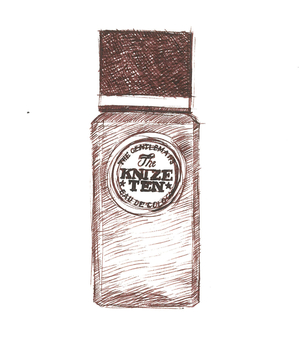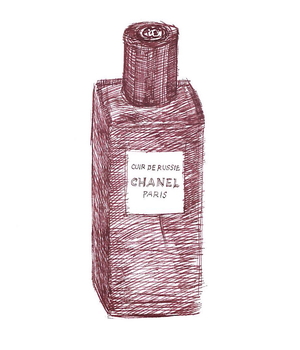Tagged With ‘Ernest Beaux’
Knize
Knize Ten
8 May, 2015

The year 1924 was a great one for perfume, if only because it saw the launch of both Chanel’s sumptuous Cuir de Russie and this, the wonderful Knize Ten. That both have survived into the present day is a bit of a miracle, but though they’re both usually placed in the ‘leather’ category of fragrances, they could hardly be less similar.
Cuir de Russie is a wonderfully rich and complex perfume, but its oddly androgynous combination of smoke and leather with a heavy floral note can make it rather difficult to wear. Knize Ten is a much more immediately appealing, fresher-smelling scent, and its leatheriness is tempered with the kind of zesty and herbal ingredients you’d expect to find in a classic eau-de-cologne – things like bergamot, lemon and geranium.
These gradually fade away on the skin, leaving a lovely, long-lasting but not overpowering leathery scent, less smoky than it is sweet. To me it also has a strong whiff of heliotrope – those electric-blue park bedding plants whose cherry-pie scent can be so intoxicating on a hot still high-summer’s day – but others may detect more than a hint (if I remember it right) of Plasticine; not unpleasant in itself, but enough to add a touch of childhood to the mix.
If Cuir de Russie is a testament to the genius of Ernest Beaux (whose greatest triumph was Chanel No 5), then Knize Ten is a fitting monument to François Coty (the mass-market perfume pioneer) and his brilliant technical director, Vincent Roubert (who had previously worked with Ernest Beaux in Grasse, then the perfume capital of France). It was commissioned, rather unusually, by a bespoke men’s tailoring company from Vienna, Knize, whose boutique is still going strong today. I’d wondered whether Knize Ten was the sole survivor of nine other fragrances, but it turns out that the name was dreamed up by their advertising director of the time, who beat Ralph Lauren by at least 50 years by seeking to associate the company with the aristocratic imagery of polo: the name ‘Ten’ was chosen to reflect the highest handicap in the game.
I love everything about Knize Ten: not just its instantly appealing smell but the smart glass bottle, with its crisply bevelled corners and chunky black cube of a cap. I’ve read somewhere that, like the company’s Viennese store, it was designed by the legendary Austrian architect Adolf Loos, and although that seems like wishful thinking it could be true; Loos designed further shops for Knize in Paris and Berlin, so their association was obviously close, and the dates look perfectly plausible too.
Even the typography of the label – a bold slab serif in a Victorian playbill style – is punchy and confident, just like the perfume inside. And while it’s far less widely available than it deserves to be, it’s not even that expensive by contemporary standards: what’s not to like?
Chanel
Cuir de Russie
23 November, 2014
 Would you smear yourself with diluted tar? That’s my first question. My second question: would you pay £150 or more to smear yourself with diluted tar? If your answer to either (or both) of these questions is ‘Not on your nelly’, then it’s possible that Cuir de Russie is not for you. If, on the other hand, you have an adventurous spirit and an interest in history, read on.
Would you smear yourself with diluted tar? That’s my first question. My second question: would you pay £150 or more to smear yourself with diluted tar? If your answer to either (or both) of these questions is ‘Not on your nelly’, then it’s possible that Cuir de Russie is not for you. If, on the other hand, you have an adventurous spirit and an interest in history, read on.
Chanel’s Cuir de Russie is widely regarded as one of the most luxurious perfumes you can buy, and there are good reasons for that. It’s one of the perfumes in Chanel’s Les Exclusifs range, all of which use the highest-quality raw materials. And it was concocted – at least in its original form – by Ernest Beaux, the perfumer whose name should really be on every bottle of Chanel No5, since it was Beaux, not Coco Chanel, who created it.
But back to tar. Tar comes in many forms, the best-known being bitumen or asphalt, the stuff that binds road surfaces together and sticks to your shoes in hot weather. You wouldn’t want to dab yourself with bitumen, not least because it smells revolting, but other kinds of tar are a different matter.
Burn wood in the absence of air and you get charcoal, but do the same to the papery sheets of bark that peel off silver birch trees, and out oozes a sticky black gloop with a rich smoky smell. This dense chemical mix of hydrocarbons and phenols is known as rectified birch tar, and it’s packed with delicious molecules such as guaiacol, cresole, catechol, pyrogallol and 5-methyl-pyrogallol dimethyl ether.
In Russia, which has no shortage of birch forests, birch tar became an important export product from the sixteenth century on. It had many uses, not least as an all-purpose glue, but the reason I’m writing about it now is because of the discovery that, if freshly tanned cowhide was impregnated with birch-tar oil, the resulting leather was not only waterproof and mould-resistant, but also developed an extremely pleasant smell.
Russian leather – or cuir de Russie, as it was known in France – gained an unrivalled reputation for quality, especially at the luxury end of the market. Ernest Beaux, who was born in Moscow and followed his brother into a job at the imperial perfumers, Rallet & Co, would have discovered the alluring smell of tar-impregnated leather early on, and it must have carried nostalgic memories for him when he left Russia for Paris in the wake of the Revolution.
The relentlessly social-climbing Gabrielle Chanel, for her part, had a Russian connection of her own: Grand Duke Dmitri Pavlovich, one of Rasputin’s assassins, with whom she had a short affair in 1920-21. It was through Pavlovich that Beaux first met Chanel, but which one of them came up with the idea of a perfume called Cuir de Russie isn’t clear. It was launched in 1924, three years after No.5, and was worn, from the first, by both women and men.
Though the use of rectified birch tar in perfumery is now restricted in the EU, and Cuir de Russie was ‘reorchestrated’ (for which read ‘reformulated’) by Chanel’s in-house perfumer Jacques Polge in 1983, it is still, it’s said, a fair approximation of Ernest Beaux’s original scent, though perhaps a little less rough-edged than the original.
Whatever the truth – and truth is a vanishingly rare commodity in the perfume industry – it’s still a wonderful smell, smoky and leathery and smooth, with no single ingredient taking centre stage. Beaux added aldehydes (the chemicals that give No.5 its glittery zing) but Cuir de Russie also includes jasmine, iris, sandalwood and rose, among other luxurious things, and it’s this balance of ‘masculine’ and ‘feminine’ scents that make it both immensely alluring and oddly difficult to place.
If ever a perfume was androgynous, then Cuir de Russie is it. Though I’m a great fan of ambiguity, and I certainly appreciate its sheer, unadulterated luxury, I have to admit that its mix of masculinity and femininity, powdery sweetness and smoky bitterness, does sometimes make it rather hard to wear. Still, it’s wonderfully long-lasting, without being overpowering, and for an expensive scent that’s surely a good thing (though as it comes in a stonking 200ml bottle, Cuir de Russie is actually better value than a lot of supposedly ‘cheaper’ perfumes). As for whether I’d wear diluted tar, I think the answer is yes.
What’s in a list?
11 June, 2014
I’m not a great cook, but even I know that a list of ingredients isn’t much use on its own. I mean, if I was to tell you I was going to make something with butter, sugar, flour and eggs, you wouldn’t really be much wiser, would you? We might all know what butter, sugar, eggs and flour taste like individually, but combine them in one way and you get pancakes; mix them together in another and you get brioche or a Victoria sponge.
Perfume is no different, which is why I get so cross every time I flick through a magazine or click through a website and read a new fragrance described almost entirely by way of its ingredients. Here’s a fairly typical example. ‘XXX blends a wild rose accord with the traditional and mysterious notes of cistus labdanum, amber and benzoin. White pepper, freesia and South American maté leaves add a contemporary touch of clarity…’
It all sounds very nice, and I can imagine what some of those ingredients might smell like on their own, but I really haven’t the faintest idea what they might smell like together – not least because we’re not told which ingredients are used in which proportion. Trying to reconstruct it in your mind’s eye (never mind in reality) would be like have a recipe that listed the ingredients but didn’t give any weights or quantities.
Another problem with listing ingredients is that, in the hands of different perfumers, two perfumes with the same ingredients can end up smelling completely different. I’ve smelled a few myself, where one is great and the other is revolting – and it’s worth bearing in mind the famous story about Ernest Beaux, the creator of Chanel No. 5, who said of Aimé Guerlain, ‘When I use vanilla, I get crème anglaise; when Guerlain uses it he gets Shalimar…’ – one of the greatest perfumes ever made.
It’s tempting to blame time-pressed journalists (of whom there are plenty), rehashing churned-out press releases from the various brands’ marketing departments (some of which are better than others), but actually I think it’s the magazine and newspaper editors who should take most of the blame, with the rest of it going to the perfume industry.
For there are too many new perfumes coming out to cover any of them in much depth (something I’m trying to counteract here at The Sniff Box). And it’s vanishingly rare for a magazine to give their writers enough room to describe a perfume properly, even if they were keen to do so.
The result? And endless gush of virtually meaningless lists, which tell readers almost nothing and do little to help people learn more about perfume or how to describe it. Is it any wonder that perfume is so often dismissed as being frivolous and expensive, when editors – who are supposed to be informing and educating their readers, after all – don’t take it seriously themselves?